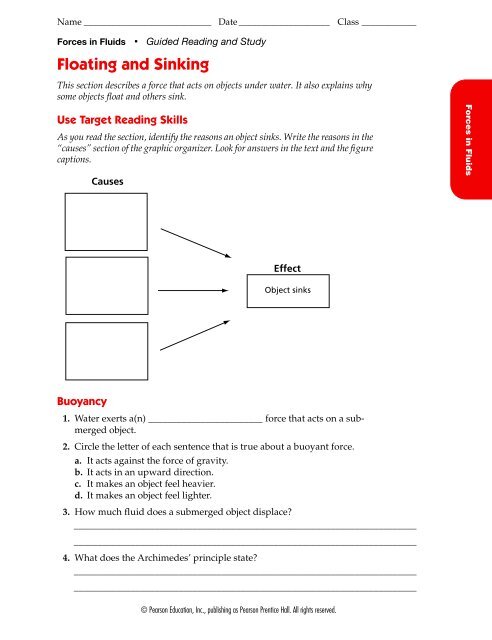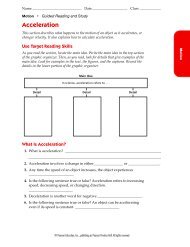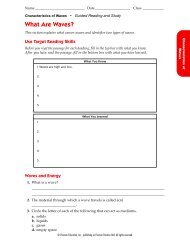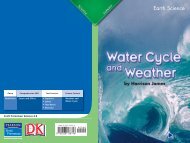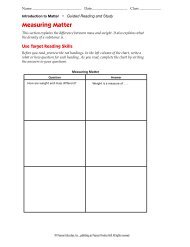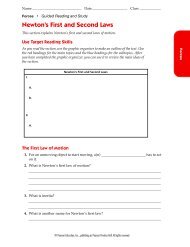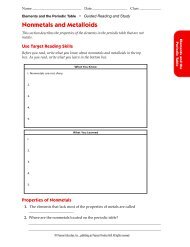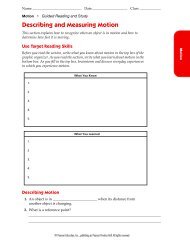3.2 - district87.org
3.2 - district87.org
3.2 - district87.org
You also want an ePaper? Increase the reach of your titles
YUMPU automatically turns print PDFs into web optimized ePapers that Google loves.
Forces in Fluids<br />
Name ____________________________ Date ____________________ Class ____________<br />
Forces in Fluids ■ Guided Reading and Study<br />
Floating and Sinking<br />
This section describes a force that acts on objects under water. It also explains why<br />
some objects float and others sink.<br />
Use Target Reading Skills<br />
As you read the section, identify the reasons an object sinks. Write the reasons in the<br />
“causes” section of the graphic organizer. Look for answers in the text and the figure<br />
captions.<br />
Causes<br />
Effect<br />
Object sinks<br />
Buoyancy<br />
1. Water exerts a(n) ________________________ force that acts on a submerged<br />
object.<br />
2. Circle the letter of each sentence that is true about a buoyant force.<br />
a. It acts against the force of gravity.<br />
b. It acts in an upward direction.<br />
c. It makes an object feel heavier.<br />
d. It makes an object feel lighter.<br />
3. How much fluid does a submerged object displace<br />
________________________________________________________________________<br />
________________________________________________________________________<br />
4. What does the Archimedes’ principle state<br />
________________________________________________________________________<br />
________________________________________________________________________<br />
© Pearson Education, Inc., publishing as Pearson Prentice Hall. All rights reserved.
Name ____________________________ Date ____________________ Class ____________<br />
Forces in Fluids ■ Guided Reading and Study<br />
Floating and Sinking (continued)<br />
5. Is the following sentence true or false If the weight of a submerged<br />
object is less than the buoyant force, the object will sink.<br />
________________________<br />
6. What happens when the weight of a submerged object is exactly equal<br />
to the buoyant force<br />
________________________________________________________________________<br />
________________________________________________________________________<br />
________________________________________________________________________<br />
Density<br />
7. The ________________________ of a substance, no matter what state or<br />
shape, is its mass per unit volume.<br />
8. What formula do you use to find density<br />
________________________________________________________________________<br />
9. What is the density of water ________________________<br />
10. The illustrations above show three objects in water. All three objects are<br />
equal in volume. The captions for these illustrations are listed below.<br />
Write the letter of the correct caption under each illustration.<br />
a. Object is more dense than water.<br />
b. Object is less dense than water.<br />
c. Object has a density that is equal to water ’s density.<br />
11. Is the following sentence true or false An object that is more dense than<br />
the fluid in which it is immersed floats to the surface.<br />
________________________<br />
© Pearson Education, Inc., publishing as Pearson Prentice Hall. All rights reserved.
Forces in Fluids<br />
Name ____________________________ Date ____________________ Class ____________<br />
Forces in Fluids ■ Guided Reading and Study<br />
12. An object that is ________________________ dense than the fluid in<br />
which it is immersed sinks.<br />
13. Why does a helium balloon rise in air while an ordinary balloon filled<br />
with air does not<br />
________________________________________________________________________<br />
________________________________________________________________________<br />
________________________________________________________________________<br />
________________________________________________________________________<br />
________________________________________________________________________<br />
________________________________________________________________________<br />
14. When a submarine pumps water out of its floatation tanks, its density<br />
decreases and it floats. Why does its density decrease<br />
________________________________________________________________________<br />
________________________________________________________________________<br />
________________________________________________________________________<br />
________________________________________________________________________<br />
15. Usually, the hull of a ship contains a large volume or air. Why<br />
________________________________________________________________________<br />
________________________________________________________________________<br />
16. The amount of fluid displaced by a submerged object depends on its<br />
________________________.<br />
© Pearson Education, Inc., publishing as Pearson Prentice Hall. All rights reserved.


